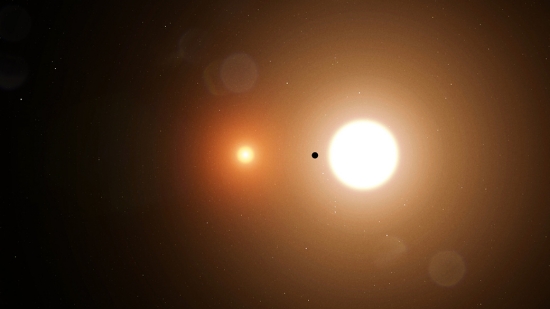TOI 1338b is a great catch, a circumbinary world that turned up in TESS data and was announced at the ongoing meeting of the American Astronomical Society in Hawai’i. Ravi Kopparapu (NASA GSFC) describes the discovery process in the essay below. The system lies 1,300 light years out in the constellation Pictor, with the planet transiting the larger star. Dr. Kopparapu’s work on exoplanet habitability is well known to Centauri Dreams readers. See, for example, his How Common Are Potential Habitable Worlds in Our Galaxy?, which ran in 2014. He followed this up with a look at an unusual multi-planet system (Ravi Kopparapu: Looking at K2-72). Analyzing habitable zone possibilities around different kinds of stars, as well as modeling and characterizing exoplanet atmospheres, plays a major role in his research interests. Here Dr. Kopparapu tells us about the new world and the significant role of an intern in its discovery, reminding us that the opportunities for young scientists to make a difference are abundant in this burgeoning field.
by Ravi Kumar Kopparapu

Back in December 2015 a couple of my colleagues, including Dr. Veselin Kostov from SETI Institute (who is now based at NASA Goddard) and Prof. Bill Welsh from San Diego State University (SDSU), met at a conference in Hawai’i. Veselin and Bill are astronomers well-known for discoveries of planets around binary star systems in the Kepler mission data. The topic of the discussion was submitting a NASA proposal to study the habitability of planets around binary stars. Planets in multiple star systems experience different kinds of illumination from their Suns (plural), varying periodically as the stars orbit each other, so the seasons or climate may be completely different than ours. It was decided that my theory colleague, Dr. Jacob Haqq-Misra from Blue Marble Space Institute of Science (BMSIS), will lead the proposal. A year or so after we submitted the proposal, we received a notification from NASA that our proposal was accepted. We were thrilled about this outcome and looked forward to start working soon.
About 2 years later, in January 2018, I received an email from a high school student named Wolf Cukier, asking if I could be his summer (2018) mentor for a high school project. His resume looked great, and he did his homework related to our group’s research. All was set and Wolf arrived in the summer of 2018.

Image: TOI 1338 b is silhouetted by its host stars. TESS only detects transits from the larger star. Credit: NASA’s Goddard Space Flight Center/Chris Smith.

Wolf worked with me on the project that we got funded through NASA. The project was to identify the habitable zones (HZs) of an Earth-like planet orbiting around two stars, which themselves are orbiting each other. These are called circumbinary planets (CBPs). We used a climate model to estimate the HZs around a variety of CBPs. I found that Wolf was a quick study and is capable of handling far more complex assignments. However, it was the end of his summer internship, so he had to leave. To tie up Wolf’s project with me, he and I started drafting a paper for publication, while Wolf was attending his school.
Image: NASA intern Wolf Cukier. Credit: Ravi Kopparapu.
Meanwhile at NASA, I mentioned to Veselin that Wolf would be very well suited to look for planets in the TESS mission data, particularly to search for circumbinary planets. At that time, only the Kepler mission had discovered transiting CBPs (about 10 of them). As exciting as these are, the small number leaves a vast gap in our understanding of this new class of worlds, not unlike the state of exoplanet science 20 years ago, when only a handful of hot-Jupiter exoplanets were known. Among the unknowns are the formation and migration efficiency of CBPs, their orbital architectures and occurrence rates. Therefore, discovering more CBPs in TESS mission data will open opportunities to answer these questions.
Veselin agreed that it would be a good project, particularly considering that no CBP was discovered by the TESS mission yet. Consequently, I offered Wolf another summer internship opportunity for 2019, with paid work through the NASA intern program. However, by summer, my calendar was booked with conference travel. It became so busy that I was not even going to be in town when Wolf would arrive to sign him in. I requested Veselin to take Wolf under his wing, which was going to happen anyway because of the work, but much earlier than Veselin expected. Being a great gentleman, and one of the nicest people I know, Veselin agreed.
I came back to my office from one of my conference travels, two days after Wolf joined, and was getting ready for my next conference travel. The next day, I got a cryptic message from Veselin asking if we all three could meet. I was concerned. What could it be? It couldn’t possibly be a discovery because Wolf just started 2 days ago. It would take weeks, sometimes months to even find a candidate planet, and that too for a high school student who is just learning data analysis. Was it not working out between Wolf and Veselin?
They came to my office the next day. I could see both were trying to hide something because both of them were containing, or trying to contain, their smiles. A small suspicion deep inside my mind started taking root. Veselin started, “We got something,” and quickly added “but we have to make sure”. Apparently within three days since he arrived at NASA, Wolf noticed that in one of the light curves there was both a prominent primary eclipse and an additional unknown feature.
This was initially flagged as an eclipsing binary on the Planet Hunters TESS platform. Planet Hunters is a citizen science project where in addition to primarily tagging transit-like features, volunteers may tag targets as various phenomena, including eclipsing binaries, variable stars, etc., thus effectively creating informal catalogs. These catalogs will be later followed-up by professional astronomers, like Veselin, to see if they are indeed candidate planets. Planet Hunters has already successfully contributed to the field of circumbinary planets through the independent discovery of Kepler-64 (also known as Planet Hunters-1).
Wolf immediately notified Veselin about the unknown feature flagged in the Planet Hunters catalog, and Veselin dutifully followed up to verify the authenticity with the help of his fellow astronomers Jeremy Orosz, Adina Feinstein and Bill Welsh. Veselin has a reputation of being extremely thorough and incredibly careful in analyzing candidate planets, so his standards for confirmation of a planet are pretty high, and if he says there is a planet in the data, you can take it to the bank. When Veselin came to my office to tell me that they may have discovered TESS’s first circumbinary planet, with the help of a high school student, I paid full attention.
They found a Saturn-sized planet in a 95-day orbit around both the stars, which means the planet is the longest period circumbinary planet found by TESS. The stars themselves orbit each other in 15 days, with one star being Sun-like and the other one a smaller, cooler star (effective temperatures of 5976 K and 3657 K, respectively. For comparison, the Sun is 5780 K). The planet is not in the habitable zone of its host stars (which Wolf verified based on his work from earlier summer). The system itself is estimated to be 4.4 Gyr old.
Video: Researchers working with data from NASA’s Transiting Exoplanet Survey Satellite (TESS) have discovered the mission’s first circumbinary planet, a world orbiting two stars. The planet, called TOI 1338 b, is around 6.9 times larger than Earth, or between the sizes of Neptune and Saturn. It lies in a system 1,300 light-years away in the constellation Pictor. The stars in the system make an eclipsing binary, which occurs when the stellar companions circle each other in our plane of view. One is about 10% more massive than our Sun, while the other is cooler, dimmer and only one-third the Sun’s mass. TOI 1338 b’s transits are irregular, between every 93 and 95 days, and vary in depth and duration thanks to the orbital motion of its stars. TESS only sees the transits crossing the larger star — the transits of the smaller star are too faint to detect. Its orbit is stable for at least the next 10 million years. The orbit’s angle to us, however, changes enough that the planet transit will cease after November 2023 and resume eight years later. Credit: NASA’s Goddard Space Flight Center.
The chain of events started in Hawai’i with a dinner chat, which led to a NASA grant. It in turn helped to recruit a diligent high school student, who helped meticulous astronomers confirm the first circumbinary planet discovered by the TESS mission. This is an exemplary example of how teamwork and valuable contributions from the most junior scientist to the senior, can produce high impact science.



Thanks Ravi.
Congratulations on TOI-700d too. Nice work. Happy times for TESS !
Best wishes
That is super cool. Congrats to you, Wolf, and Veselin!
That’s not all Santa brought back from the TOI store https://www.nasa.gov/feature/goddard/2020/nasa-planet-hunter-finds-its-1st-earth-size-habitable-zone-world (Yes, it’s a red dwarf, but no flares at least for now)
It is an interesting 3 body problem with the orbit of the planet varying in both period and orbital plan. Looks like the habital zone would be further out then our sun, probably any earth size planet would be in a stable orbit at 1 AU. The TOI 1338b is orbiting at about the same distance as mercury in our system but may cause tides on planets in the habital zone. This could work in a similar fashion as our moon with a similar tidal period.
Correction, the tidal periods from planet b for a planet in the habital zone would be around 120 days if in a 400 day orbit. Dr. Kopparapu what are the orbital distances between the two stars and the distance in AU for plane b?
4.4 by? That’s surprisingly stable. Going back to the beginning, the dynamics of planet formation would have to be very interesting.
Dr Kopparapu: I know that this is a bit OT, but yesterday I read an abstract of a paper you were a co-author of: “Sensitive probing of exoplanetary oxygen via mid-infra-red collisional absorbtion.” Does this mean that JWST can detect oxygen in the atmospheres of the TRAPPIST-1 planets even if their atmospheres are completely covered by clouds?
The straight answer is “no”.
The thrust of the article you refer to is that “collision induced absorption” (CIA) of oxygen atoms provides a strong spectral signature at 6.4 microns. But even that might only be enough to be detectable by JWST aperture transit spectroscopy for Trappist-1 style planets with erstwhile terrestrial style atmospheres of stars within just 5 parsecs. i.e a lot nearer than the reality .
There is parallel paper published by the authors on Astro-ph that explores 3D climate modelling of Trappist e and calculates the number of planetary transits required to obtain different gaseous absorption spectra on a JWST observation run – assuming a terrestrial style atmosphere. It factors in clouds. These absorb extensively in visible and IR wavelengths – just the sort of wavelengths that terrestrial biosignature absorption spectra occur in.
Terrestrial style atmospheres, though possessing high molecular weight are, like the Earth – only shallow , which don’t provide much of a target for the stellar photons to pass through prior to undergoing transit spectroscopy. Remember too that for transit spectroscopy only a narrow band of atmosphere around the planetary terminator is utilised. A small part of an already small target. Near a very dim photon poor star. Cloud cover dramatically reduces the atmosphere that can be utilised even further .
So complete cloud cover would block CIA markers even for high bar O2 atmosphere produced by photo desiccation . No chance fir a much lower pressure biological example. However photodessication ( via photolysis of water) would remove water from any atmosphere leaving it more likely to be cloud free over time . Hence greater sensitivity for such ( still hypothetical ) atmospheres for distances beyond 5 parsecs.
In terms of JWST transit spectroscopy and Trappist-1, for the “Hab zone” planets (d,especially e and f ) it’s likely that the most easily detectable terrestrial atmospheric marker will thus be CO2 . But even that would be significant as given the prolongued stellar activity of M dwarf stars ( of which Trappist-1 is a fairly representative exemplar ) proof of the presence of anything rather than either a thick H/He envelope – or no atmosphere ! – would be a defining moment .
There is also a new(that’s right: NEW -more on this later)Kepler MAIN MISSION(i.e. NOT K2)circumbinary planet: Kepler 1661 AB b. This is exciting news in itself, but what is REALLY IMPORTANT to me is that, even after the Kepler mission was officially terminated, NEW Kepler designations are STILL being given out to CONFIRMED KOI planet candates(although, foe some unknown reason, NOT to confirmed KIC planet candidates that never achieved KOI status)Case in point: Kepler 1661 AB b was previously designated as KOI 3152.01. WHY this so important to me is as follows: Jeff Caughlin tweeted this on December 19 last year – “This was a huge effort to manually vet thousands of #Kepler mission KOI’s by the False Positive Working Group over several years. Some planets were rescued, some destroyed. This is APPARENTLY(correct me if I am wrong)the final FINAL attempt to vet KOI’s by astronomers ASSOCIATED with the Kepler Mission(although attempts by outside groups may be made in the future). I was hoping these findings would be made PUBLIC by now(hopefully at the ongoing AAS meating)but so far, nothing. I am hoping that there will be an outside chance that KOI candidates 7923.01, 8012,01, 8164.01, so prominently presented on Andrew LePage’s “Drew Ex Machina” website will FINALLY achieve Kepler designations, abd dreading any DELETIONS of other prominent Kepler discoveries.
OOPS: I meant KOI 8174.o1, NOT KOI 8164.01
To give you some sense as to how much the pace of new Kepler designations has slowed down, case in point: Kepler 1625 b. This much ballyhooed(because it MAY host a giant exomoon)planet was given its Kepler designation way back in 2016. That means just 36 MORE Kepler designations have been given out since then, or less than ten a year. When this new study is made public, there will probably be a whole bunch of new Kepler designations, and then it will dwindle to pretty much nothing after that.